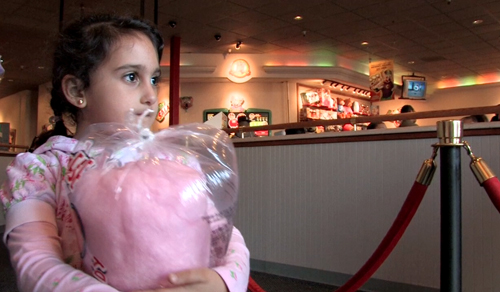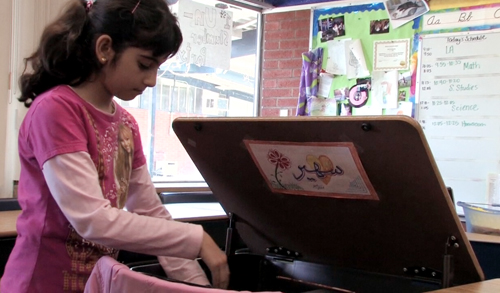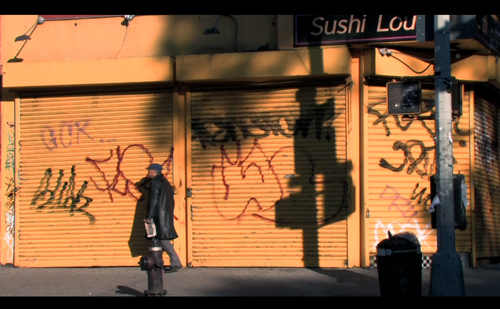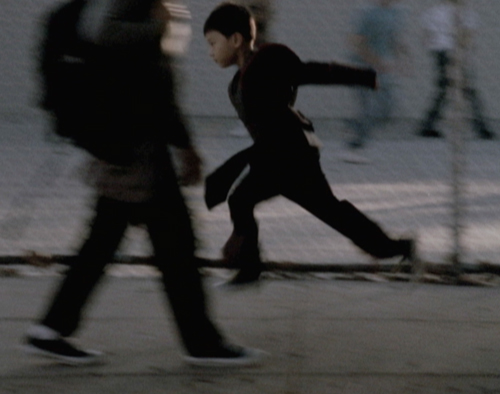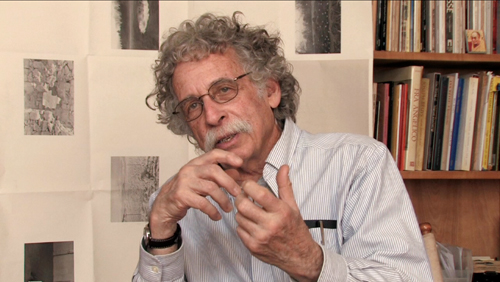Tanya Sleiman: Capturing Elusive Photographer Helen Levitt on Film
Through a Lens Brightly: Women, Photography & Change –
A Blog Series in Honor of Women’s History Month.
 “Before street photographers took Manhattan by storm, there was Helen Levitt. An artistic pioneer and the ultimate photographer’s photographer, Levitt lived as a total enigma, determined to dodge the public eye in favor of what she loved most: poker, baseball, and, above all, capturing the city at play. 95 Lives searches for the many, colorful lives of this female pioneer and the formidable contributions she made to 20th century art and to the city that shaped her incredible body of work: New York.” (Kickstarter campaign for 95 Lives, a film about Helen Levitt by Tanya Sleiman)
“Before street photographers took Manhattan by storm, there was Helen Levitt. An artistic pioneer and the ultimate photographer’s photographer, Levitt lived as a total enigma, determined to dodge the public eye in favor of what she loved most: poker, baseball, and, above all, capturing the city at play. 95 Lives searches for the many, colorful lives of this female pioneer and the formidable contributions she made to 20th century art and to the city that shaped her incredible body of work: New York.” (Kickstarter campaign for 95 Lives, a film about Helen Levitt by Tanya Sleiman)
 Tanya Sleiman is a documentary filmmaker with an MFA from Stanford University. She currently teaches at Diablo Valley College in California, and recently taught with NYU Tisch School of the Arts in Cuba as the 2011 on-site Program Director for documentary production.
Tanya Sleiman is a documentary filmmaker with an MFA from Stanford University. She currently teaches at Diablo Valley College in California, and recently taught with NYU Tisch School of the Arts in Cuba as the 2011 on-site Program Director for documentary production.
Sleiman’s 2008 visual essay, A Chronicle Of Concrete, was screened in international festivals and broadcast on PBS. She also produced Iraq in the USA, a vibrant collective portrait of Iraqi refugees in America. In 2008, Sleiman began examining Helen Levitt’s legacy, sharing a short film project at the Cantor Arts Center for In a New York Minute: Photographs by Helen Levitt (April, 2011). She is currently at work on a longer film about the photographer called 95 Lives.
While Sleiman calls herself an “ordinary person,” it is clear she is anything but. Here are some of her insights on Helen Levitt and changes in the field of photography since Levitt’s day.
PWP: How did you get interested in film?
Two sources were my fuel for film: Berkeley’s Pacific Film Archive launched it and New York’s international and experimental scene sealed the deal. I was in my 30′s when I discovered it was for me. Earlier as an undergrad, I pursued social sciences at Berkeley, where there happened to be an amazing art house cinema space, The Pacific Film Archive. I didn’t know it was world-class then. I only knew it was another amazing resource on the campus. I went to the PFA whenever I could to watch art films as a “break€ from my social theory studies. Watching a film was always a window to another world, another set of metaphors for life. I loved it. Yet in my years of undergrad studies, I never imagined I’d be someone who would make films. I thought I’d be a diplomat or a policy maker or educator or social justice crusader. Something responsible, something that made a difference. To me, film and photography were hobbies, not professions. I didn’t take a single art history class. I took painting-for fun. Art was on the level of dance for me. Something you do to unwind and explore, not something you make to change the world. After undergrad, I moved to Damascus, Syria, to study Arabic literature and language. There, I continued to watch international cinema, with films from the Arab Middle East as well as any cinema that came to town through the cultural centers of India, Spain, and France. Still, I didn’t think I’d make or study film.
When I moved to New York City after Damascus, my free time was once again at the movies. After my attending many screenings with the artists present, I began to see that the filmmakers didn’t look too different from me. I began to think I might be able to tell stories through image and sound. In 2005, I picked up a video camera for the first time with an aim of making my own film. I didn’t have a particular story to tell; rather, I had a deep urge to learn how to make films. So I enrolled in a continuing ed class at The New School, where I worked. It was documentary production. I was familiar with still photography, but not film/video. I have zero home movies from my childhood.
With my first film, I made classic rookie mistakes, such as turning the video camera vertically to frame a shot of squirrels scampering up a tree.This was the beginning of my learning how to un-see what the human brain perceives. Of course, now smart phone cameras change aspect ratios for us as we switch our compositions! Despite my backwards composition obstacles, I had success too, and much of it was because I worked with a partner, Richard Adams. We complemented each other: what I lacked in technique, he had. I brought people skills and good interviewing style to our documentary. We both had a good eye for composition or interesting subject material. After finishing our short documentary that fall, I knew I was ready to move full time into film. I quit my education administration job, drew on personal savings, and enrolled in NYU film school’s continuing ed program to make my own films. For me, it was about documentary’s power to combine so many things I love in a dynamic way: art through the image and sound production; interacting with people; and storytelling and educational elements if you’re lucky. And no day is the same, which I love.
PWP: What led you to make a film about Helen Levitt? Was there a personal encounter or was it simply appreciation from afar?
The answer truly began with a question: how come I don’t know Helen Levitt?! How could there be nothing documenting her legacy? I didn’t know anything about Helen Levitt until the year I first studied her work. In general, I love images which capture ordinary life. Levitt’s scenes with texture in beauty and grit, humanity’s grace and awkwardness, as well as our humor and melancholy, captivated me in a master class with a curator of photography at the Metropolitan Museum of Art. It was a week of looking at images, not making them. Each day that week, we examined an artist in depth. Masters such as Eugene Atget, August Saunder, Henri Cartier-Bresson, and Walker Evans were our beginnings. With each master, I knew the artist’s biography and something about their images. Though I neither studied photo history nor photography in undergrad, I had enjoyed an entire decade of New York City’s gallery and museum scene, and I was always in the photography galleries.
However, when we got to the Helen Levitt day, I had zero information about the artist behind the images. I’d absolutely seen her images before. How come I knew nothing about the artist? How could I not know anything about a major female photographer? I asked the Met curator: which documentaries (plural) should I watch to learn more about Levitt? He told me, “no documentaries exist on Levitt.” I was shocked. I asked why. He said something about Ken Burns trying and failing. I later would learn, the curator meant Ric Burns who made a PBS series on New York and uses some of Levitt’s images in one scene and probably tried to get Levitt to participate.
With that glaring absence, that appalling lack of a film on a major artist, I was convinced I would use the opportunity of my MFA thesis film to make a modest film on Helen Levitt. She was still living that year, so I flew to New York that October to meet her. When I asked what she thought about my making a small film about her life and legacy, she said very matter-of-factly, “Wait ‘til I’m dead, hon.€
PWP: What made you go beyond appreciation to take action?
How could I not make a film? I felt I had discovered an enigmatic treasure and had to share it. The feminist in me was determined to celebrate a major female pioneer. The documentary artist in me was gripped by the images. The history lover in me could travel in time straight to the moment the images were captured. Last but not least, we live in an era where films reach audiences in ways that art monographs simply cannot. I am committed to making a lyrical film, combining the master artist’s eye and my research to share how she transformed real streets into theater. At first, I thought a modest short documentary would be a great first step. The more I researched however, the more I discovered a fascinating person whose innovative work had to be told through film.
I have been unearthing archival gems, finding hidden stories, collecting oral history, creating soundscapes and vivid scenes. I can’t wait to share the work and enjoy viewers’ own encounters with Levitt’s images.
PWP: The legacies photographers leave behind and their preservation can be troubling. Gifted people vanish without a trace as tastes change and time moves on. The work of Eugene Atget and Vivian Maier had near misses with oblivion. Why was Levitt important? What about the legacies of photographers in general?
So many stories around Levitt and her work are gripping. First, how did she choose to portray 1930s Black and Spanish Harlem life with vitality and mystery, despite American documentary’s Depression-era aesthetics? Second, in the 1950s why did she embrace color when photography’s elite thought it vulgar? Third, how did she work with motion pictures on the streets of Harlem decades before cinema verité had a name? Throughout, how did she, as a woman hold her own in a dominantly male photographers’ club, at a time when it seems it was harder than it is now? Unfortunately, it is now nearly 4 years since she died and it is very unclear how her legacy will be officially promoted and preserved. With many photographers, their work immediately increases in market value after their passing. It is not always the case that an estate is named, or that an estate is ready to work with institutions to promote archiving, preservation, organization, education, and research. The cases of Atget and Maier are great examples of the physical archive needing preservation and dissemination. With artists working now in digital realms, how will future discoveries uncover work on a floppy disk when there is no hardware to run it? I am grateful that a few centers globally are taking seriously the challenges of digital file migration, but I suspect it will be much harder in future for someone like Vivian Maier to be a discovery. Levitt will not go to the trash bins of history because she is well-chronicled within photo history. My urgency to make a film about her life and legacy is driven by the belief that Levitt’s best work is from the street. I feel deeply that it is time to remove the mystique around her process to explore her unique way of seeing because I believe it can inspire us in our current moment to look not at our handheld devices, but instead, to look up and around our world with fresh eyes.
PWP: Levitt dropped out of high school, began working for a commercial portrait photographer, and had early and direct contact with greats in the field. Can you compare her photographic education with the art/graduate school route taken by many photographers today?
With the art/grad school route, there is an overt professionalization. Artist’s statements; teaching credentials; certification of proficiency in a software, etc. A positive part of school is the production of many small projects within a short period. In Levitt’s day, there were some centers for photography, and schools of thought often emerged from like-minded artists, but the real path was master-apprentice and trial by dodging and burning.
In my opinion, the best part of current art education is when a senior artist and an emerging artist can connect and their encounter changes both parties into new creative explorations. This idealized version of the master-apprentice relationship is how Levitt learned photography. Levitt formally studied only with Jay Florian Mitchell (studio). But she trained her eye on the works of Walker Evans (Americana), Henri Cartier-Bresson (street), and painting and photography in galleries and museums in New York. She was particularly struck by a show of surrealist photo images she saw in New York at the famed Julien Levy gallery. The portfolio we know today from a professionalized program was the basic idea she had when she first called on Walker Evans. She had begun exploring image-making in New York’s streets, and she brought him a set of prints for his feedback. It was the ultimate critique session because that day Evans was there with the writer James Agee, and a new partnership began for Levitt with both artists. In Levitt’s day, it was the cost of the equipment, the transportation, and the time. Today, it’s all of those elements, plus thousands of dollars in tuition. Degrees can cost a small fortune, and not every program is worth the money. For me personally, I was very keen on earning an MFA. I like academia; I value the credential for teaching; I studied film and digital production with master documentary artists; I wanted a small seminar-style program and Stanford accepts 8 students per year to study with 3 full-time documentary production faculty as well as an entire department of art practice, art history and film theory. So in my personal case, it was a good match. However, there are plenty of paths to filmmaking outside the academy.
PWP: Over the past 30 years, there have been tremendous changes in the field of photography. What used to be largely B&W and of a relatively modest scale has become large, brightly colored, and overwhelmingly digital. There is mixed media and staged imagery. Photography has entered the art world in a big way. Can you talk about how the photographic landscape was different in Levitt’s time?
Photography was still insecure in calling itself an art form when Levitt began working in 1931 (age 18) for a commercial studio photographer in the Bronx, J. Florian Mitchell. Eugene Atget in 1890 in Paris did not self-identify as an artist. He stated simply that he was providing documents for artists, i.e., photo images for “real artists€ such as painters. When Levitt started her street photography work with a used camera, completely divergent definitions of photography were competing for attention. It’s documentary. It’s reportage. It’s surrealism. It’s pictorialism. The question Walter Benjamin articulated in 1936 concerning art in the age of mechanical reproduction haunted the first images taken by a shutter, and this certainly applied to Levitt in the studio and on the street in the 1930s.
As for the camera technology and printing techniques after she left the commerical studio, Levitt started with a Voigtlander, with which she considered a portraiture career, followed by the Leica, after encountering Henri Cartier-Bresson in person in New York at a photo salon discussion. He shared why it was his preferred camera, and it became her camera of choice thereafter. Levitt printed her 35mm images and images for Walker Evans in a kitchen darkroom, and later, she used the bathroom tub in her apartment to print her images. She printed 2×2 versions of negatives she thought were promising, in order to save paper. If an image made her cut, it was enlarged, but never larger than 8×10 for her first 5 decades of work. She began in black and white, then pioneered a humanist color slide photography of New York’s streets in the 1960s, showing her color work in the MoMA several years before William Eggleston’s seminal color show. She never worked with digital, but she did enjoy a toy camera or two!
PWP: I sense in Levitt’s work a shyness and sensitivity. What was she really like?
Levitt was absolutely shy in public and hated to give interviews. She was fiercely intelligent with a sharp gallows humor that could catch strangers off guard, but kept her friends very entertained, unless they were the subject of the joke.
When I met Levitt, she was 95, and she had better posture than I did. She was as fit as someone her age could be and sharper than many 25 year-olds I teach today. She was very sensitive to the needs of her pet Binky, who was sick that day, perhaps in solidarity with Levitt, who was ill too. I spent one day with Helen Levitt and since then, four solid years researching her life and speaking with the people who knew her best. What I’ve gathered is that she was humble, yet aware that she had made good work in photography. And that she had loyal friends in different spheres who did not intersect. What I’m hoping to do in my film is bring all these lives with whom she connected into one frame.
PWP: There is also sense a general change in the way things are. In Levitt’s time, it seemed possible to self-educate, possible for a regular person to live in Manhattan, to reach out and engage directly with luminaries in their field. Even the street life seemed different. As Levitt said herself: “Children used to be outside. Now the streets are empty. People are indoors looking at television or something.€
Certainly, the 1930′s street life was radically different. Poverty in the depression meant that people knew to upcycle, recycle, reuse, repair and reinvent. Thus, the street images Levitt captured don’t have garbage cans nor garbage strewn everywhere. Air conditioning did not exist in the 1930s when Levitt started to photograph in the streets. Summer indoors in Harlem then was sweatier than a Bikram Yoga session today. Gas lamps were transitioning into electricity, however, indoor dark apartments were not very bright nor appealing in the summer. Thus, for the people Levitt photographed, Harlem’s public streets felt fresh and breezy and vast in contrast to cramped and dark interiors in tight tenement apartments. Cars did not race down the streets every two seconds, so children could use the asphalt of the roads for their art canvases with chalk drawings covering Harlem. Glass and steel were not the dominant storefront building materials, instead brick brownstones of a human scale provided children with another canvas for their chalk drawings. All these conditions in New York allowed a rich cross section of urban denizens to pass before Levitt’s lens, and her unique way of seeing the dramas and dances of the street provide us today with a superb window on the worlds these street actors inhabited.
As for the possibility to self-educate, I truly think it is a matter of reframing how we look at ourselves and our luminaries. I am an ordinary person. I was still ordinary when I wrote Levitt a letter in 2008. When she didn’t write back, I picked up the phone and called her. I figured, she’s 95. Time is of the essence. Maybe she’s too busy or too tired to write back. I never allowed myself to feel I wasn’t worthy of the task. After all, she had a public, listed number. She was hiding in plain sight. She answered the phone. We set a date, and I showed up at her door.
I’ve done the same countless times since with her friends and curators who knew her. To interview all the folks I’ve gathered for this film project, I have had to write, call, and email some of the finest luminaries of film, photography and criticism. I don’t think my Stanford MFA is why they respond. They like Levitt’s work or they knew Levitt well, and they respect my project. They trust that we can make something richer by talking or working together.
Levitt called on Walker Evans, but she knew when she was ready to show her work. I didn’t set out to make this film when I didn’t know how to hold a camera. I worked on my skills as much as I possibly could, and I set forth. My unsolicited advice to folks: work on your craft, and you will learn by doing and failing. To find a mentor, keep calling, emailing, showing up and writing to whomever you think can open a new door. You never know what you will walk into.
If a luminary you admire is to busy for you, watch their talks on the internet while you find someone else. I know it can feel daunting at times, but in this era of the internet superhighway, and air-conditioned/heated libraries and information everywhere, self-education is absolutely possible. Don’t be overwhelmed by technical issues or shyness. Find something you want to pursue and go for it with unabashed enthusiasm.
Catherine Kirkpatrick
Archive Director
Links to other articles in Through a Lens Brightly: Women, Photography & Change:
Gigi Stoll: Inspiration All Over the World
Of Her Time & Way Ahead: Beth Wilson on Maggie Sherwood
Tanya Sleiman: Capturing Elusive Photographer Helen Levitt on Film
Rivka Katvan: An Appreciation by Harriet Whelchel


